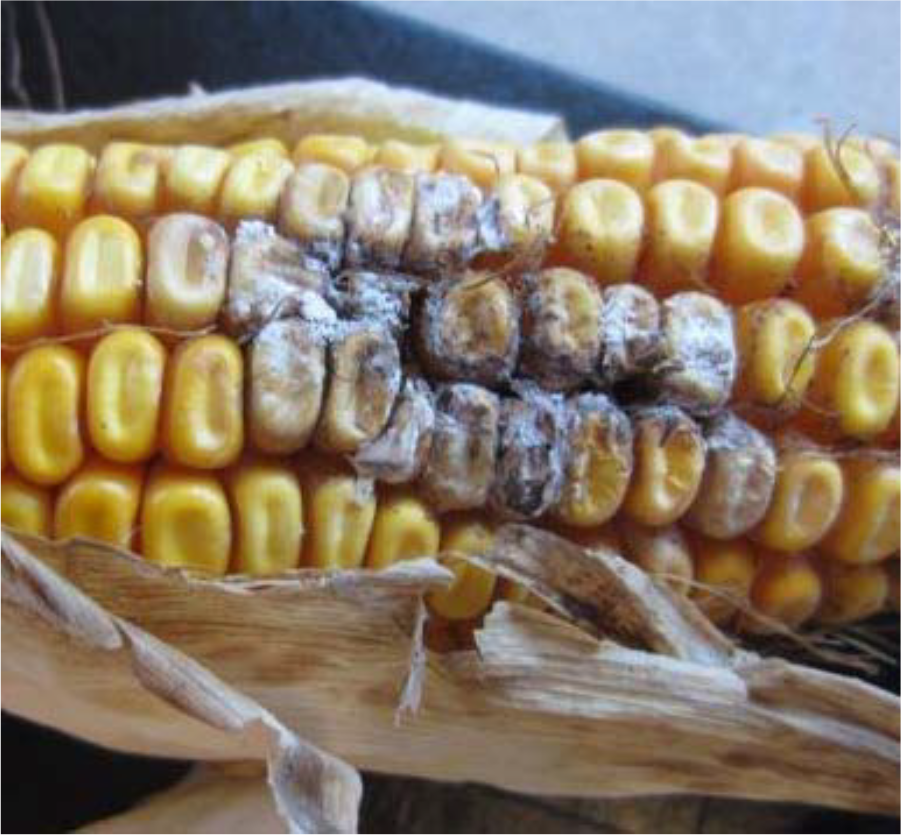⇦ Back to Livestock and Feedstuff Management Home
¶ Introduction
The term “mycotoxin” is usually reserved for potentially toxic chemical products produced by fungi that infect and colonize, especially grains. A single mold species may produce many different mycotoxins. Several mold species may produce the same mycotoxin. Mycotoxins can affect human or animal health if they consume contaminated food or feed.
¶ A. What is “zearalenone”?
- Estrogen‐like compound most commonly produced by Fusarium fungi
- F. graminearum, F. culmorum, F. cerealis, F. equiseti, F. verticillioides, and F. incarnatum
- Also produced by Gibberella fungi
- Also known as mycotoxin “F‐2” or “RAL”
- May develop in corn, barley, oats, wheat, rice, or sorghum
¶ B. Conditions favoring zearalenone production
- Mycotoxins may or may not be present if visible molds are present
- Absence of visible mold does not guarantee absence of mycotoxins
- Fusarium molds
- Are associated with ear rots and stalk rots
- Develop under wide range of environmental conditions
- Can infect seedlings and developing kernels
- Affected kernels may appear purple, tan, or brown ii. Visible mold appears white to pink or salmoncolored
- Wheat
- Excessive moisture at flowering and early grainfill stages
- Warm, wet weather at harvest
- Corn
- Cool, wet growing season
- Also, dry conditions in midseason followed by wet weather
- Insect or hail damage to ears
- Warm, wet weather at harvest
- Infection usually has minimal effect on yield
- Cool, wet growing season
- Gibberella molds
- Responsible for Gibberella ear rot
- Pinkish mold; usually begins at ear tip
- Produces both DON and zearalenone
- Overwinters on corn and small grain residue
- More prevalent when:
- rotation is continuous corn
- wheat is affected by Fusarium head blight
- cool, wet weather occurs during early silking
- fall rains delay harvest
- Responsible for Gibberella ear rot
¶ C. Interpreting zearalenone results
- Are not action levels or advisory levels for zearalenone
- “Concern” levels
- “Potentially harmful” levels
- Concern level
- Level indicating possible favorable conditions for mycotoxin development
- Additional testing of feed ingredients or rations may be prudent
- Limit amounts fed to livestock if moderate performance effects are observed
- Discontinue use (at least temporarily) if pronounced chronic symptoms or acute clinical symptoms are observed
- Continue checking for other possible causes
- Grain, ingredients, or rations exceeding concern levels are not subject to reporting or seizure
- Level indicating possible favorable conditions for mycotoxin development
- Potentially harmful level
- Indicates probable involvement of zearalenone in reduced performance, chronic symptoms, or acute clinical symptoms
- Discontinue feeding ‐ at least temporarily ‐ if either chronic or acute symptoms are noted
- Observe animals closely if symptoms are absent
- Continue testing feedstuffs or rations
¶ Table 1. Interpreting Zearalenone Tests in Livestock Feeds |
|||
| Feedstuff type: | Concern level: | Potentially harmful for: | |
| Cattle | Swine | ||
| ‐‐‐‐‐‐‐‐‐‐ mg/kg or ppm ‐‐‐‐‐‐‐‐‐‐ | |||
| Grain or grain products | 0.56 | 5.6 to 10.0 | 1.1 to 5.6 |
| Total ration dry matter | 0.56 | 3.9 to 7.0 | 0.6 to 3.9 |
¶ D. Zearalenone effects
- Mycotoxins can interact to produce symptoms different or more severe than expected
- May be due to the presence of multiple mycotoxins in contaminated feeds
- Swine disorders
- Swine more susceptible than other livestock types
- Typically little or no effect on growth.
- Estrogenic effects
- Lengthened or absent estrus cycle
- Interrupted reproductive cycles
- Cattle disorders
- Enlarged vulva
- Possible irregular heats and infertility
- Typically no abortions
¶ E. Sampling and analysis for zearalenone
- Survey fields before harvest
- From dent through to harvest, check five to ten field locations
- Target areas with plants that appear most stressed.
- Peel back the husks of 10 ears at each location and inspect for mold
- Suggested sampling procedures
- Standing grain: Collect 25 ears or heads at random throughout the field
- Grain cart/truck: Take multiple probes for a composite 10 lb. sample
- Moving grain stream: Take a composite 10‐lb sample consisting of 12 to 20 subsamples from the grain stream
- Keep samples cool, but do not freeze
- Ship promptly, early in the week, to avoid weekend delays
- Analytical methods
- Immunoassay test kits: screening, provide yes/no answer
- Immunoassay with reader: can test several mycotoxins; provides quantitative data
- Chromatography: can test all mycotoxins; provides quantitative data
¶ Figure 1. Ears With Fusarium Ear Rot Have White to Purple Mold Visible on Kernels. (cornmycotoxins.com)

¶ References
Adams, R.S. et. al. Mold and mycotoxin problems in livestock feeding. DAS 93‐21. Pennsylvania State Univ. Coop. Ext. Svc. 17 pg. http://www.das.psu.edu/research‐extension/dairy/nutrition/pdf/mold.pdf/view?searchterm=mycotoxin
Corn Protection Network. 2016. Ear Rots. http://cropprotectionnetwork.org/corn/ear‐rots/ accessed 13Sep2017
Hurburgh, C.R. Mycotoxins in the Grain Market. Integrated Crop Mgmt. News. Iowa State University Extension. http://www.extension.iastate.edu/Grain/Topics/MycotoxinsintheGrainMa rket.htm accessed 11/1/2009